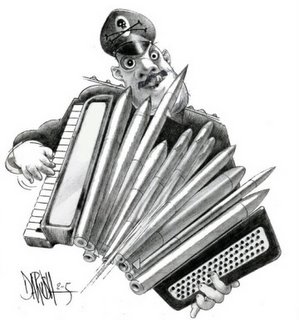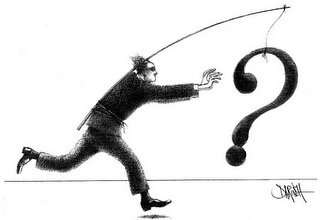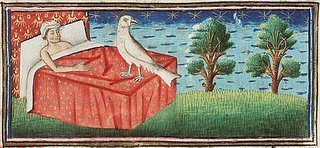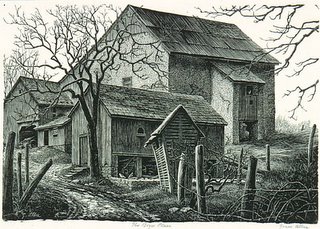Tuesday, February 07, 2006
Triangulation

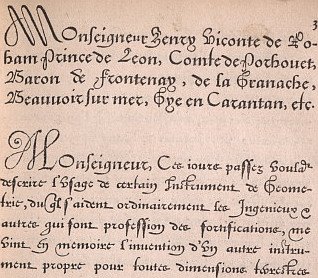
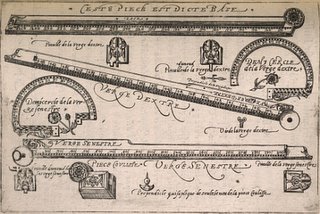
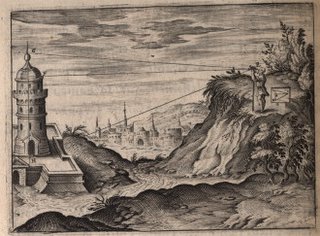


In addition to being in charge of the Paris Mint, Philippe Danfrie was also an inventor and engineer who built astrolabes and clocks and he cut his own type for his publications.
His invention seen here is a graphometer, essentially a simple theodolite with a graduated semi-circle and sight arms which could be affixed to a telescope if needed, but was mostly used for measuring horizontal and vertical angles by triangulation in surveying up until the mid-19th century.
[It was actually the beautiful lettering in the text that drew my attention and I am no typophile].
- Declaration de l'usage du Graphometre [1597] is online at the University of Virginia (thumbnail page).
- The Geometry of War at the Museum of the History of Science, Oxford University.
- Epact - Scientific Instruments of Medieval and Renaissance Europe.
Cryptic Rabanus
remember, or more laborious to write can or could ever be found."
Cluny of Odilo



9th century German theologian Rabanus (or Hrabanus or Reabanus) Maurus, also called Maurus Magnentius Rabanus or Hrabanus Magnentius, was considered to be the most knowledgeable man of his day. As an elected Abbott he helped establish Fulda as a centre of learning and Maurus's breadth of knowledge on matters both religious and secular together with his success as an educator became known throughout Europe. Later he would be appointed Archbishop of Mainz and the title of Praeceptor Germaniae ('Teacher of Germany') was conferred on him.
Among his many writings was an interesting collection of poetry - De Laudibus Sancte Crucis ('In Praise of the Cross') - "a collection of twenty-eight encrypted religious poems, rendered before 814 AD. He was said to be the inventor of a cyphering system of 36 lines containing 36 letters evenly spaced on a grid. In this grid, Maurus included figurative images, putting the poems in visual terms. The poem filling the cypher grid was enriched by these smaller images, as most of the letters contained within them created tiny individual poems." Thus his writings could be appreciated at least on one level by the largely illiterate populace.**
The top 2 images are from the (totally impenetrable to me) Vatican Library and are posted on the Almaleh website -- there is no date with them and I removed the watermarking. There are more example images at their site.
The 3rd image is from a complete 1503 copy of the work by Thomas Anshelm, posted at Les Bibliothèques Virtuelles Humanistes website which is itself notable...
"This somewhat remarkable book is the first edition of the author's poem "In Praise of the Holy Cross." The piece is printed as a figure poem, that is, a poem over which are superimposed a variety of figures. These include Christ Crucified, evangelistic symbols, cherubim, and King Louis the Pious of France. Some pages were printed entirely from movable type.
In more complicated instances, the entire page is cut with its figures on wood in imitation of type. In still other cases, the letters immediately surrounding the figure are cut on the block, while the remaining area of the page is filled in with movable type. Although figure poems were common in manuscripts, the De Laudibus Sancte Crucis is the first instance of this form of symbolic poetry to appear in printed form."
- Catholic Encyclopedia - rather dismissive of Marius's poetry.
- NNDB are even more scathing - not sure of their source.
- Biography at the Medieval Bestiary.
Addit: **That sentence is a paraphrase from the source - thinking about it later, it seems a bit improbable that books by the upper echelons would be made available to the rabble. I think the
 sentiment is rearward projection.
sentiment is rearward projection. ****UPDATE**** (August 2011): 'De laudibus Sanctae Crucis - Cod.theol.et phil.fol.122 {Lorch 1490} [In Praise of the Holy Cross] is a gorgeous manuscript and has just gone online (Stuttgart State Library) [click 'zur Werkansicht']
****UPDATE**** (December 2012) Bern's e-Codices portal has now placed a full manuscript of 'De laudibus Sanctae Crucis - Burgerbibliothek, Cod. 9' Hrabanus Maurus, Liber de Laudibus Sanctae Crucis {parchment, 11th cent.} online.
Monday, February 06, 2006
The Singular Thevet



[The above images are from Cosmographie de Levant - 1553 - a compendium of facts about the people, places, flora and fauna of Italy and the Mediterranean region]

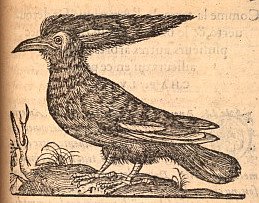
 "Andre Thevet first used the name 'Toucan' with a long description, and a woodcut of a whole bird, in his "Singularitez de la France". The Latin name "Burhynchus" or "Ramphestes" (in reference to the size of the beak) was suggested by Conrad Gesner ("Icones Avium", 1560, p.130), and Linnaeus later adopted Aldrovandus' corrupted form of the latter ("Ramphastos"), which is how the family.." name came into being (the family name survives for some species but toucans are spread across a number of families these days).
"Andre Thevet first used the name 'Toucan' with a long description, and a woodcut of a whole bird, in his "Singularitez de la France". The Latin name "Burhynchus" or "Ramphestes" (in reference to the size of the beak) was suggested by Conrad Gesner ("Icones Avium", 1560, p.130), and Linnaeus later adopted Aldrovandus' corrupted form of the latter ("Ramphastos"), which is how the family.." name came into being (the family name survives for some species but toucans are spread across a number of families these days).
[The above images are from Singularitez de la France Antarctique, Autrement Nommee Amerique, & de Plusieurs Terres & Isles Decouvertes de Nostre Temps - 1557 - this book is a description of the New World essentially]
Franciscan monk André Thevet (?1515-1590) "was one of the most widely travelled Frenchmen of the 16th century visiting almost all the main countries and regions of western Europe, the Near East, and Brazil."
The publishing history of André Thevet is reflective, as with the toucan story above, of the 'borrowing' that went on between authors and illustrators of renaissance books. After Singularitez was released, one of the transcribers sued Thevet claiming authorship and the dispute was settled, lending credence to the wide-held belief that Thevet was not responsible for much of the work issued in his name. A later collaborator on Thevet's large work, Cosmographie Universelle (1771), again had a dispute with Thevet and went off and published his own version (well, more a translation of Münster's Cosmographia) and Thevet alleged plagiarism. I'm leaving out many details but the accusations and theft seem to travel a circular route.
Scholars now apparently feel that Thevet's contributions on Brazil are worthy historical commentaries but much of his other writing on the Americas was probably obtained by speaking with such luminary explorers as Sebastian Cabot and Jacques Cartier, among others. But it was only relatively recently that the North American sections were translated into english.
Thevet claimed to have introduced tobacco plant seeds to France and he may have introduced the pineapple to Europe. But then again, I'm not sure what to believe about this character after reading a lot of confusing material.
Images from Singularitez are taken from Gesner's Historiae Animalium (1555); images from Gesner are taken from Cosmographie; both heavily relied on Münster and his natural historian antecedents and many later naturalist/explorer/authors abstracted elements from all these sources. So it goes..
- Cosmographie de Levant and Singularitez de la France Antarctique are online among the Douglas Gordon Collection at the University of Virginia.
- Commentary on Thevet from U. Virginia.
- Short review of a 1986 book on Thevet.
- Tupinamba -v- Staden.
- Topsell/Rowland - 'The Beasts Rise'.
- Early history of tobacco.
The Architecture of Embellishment
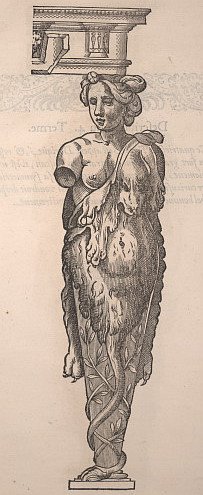
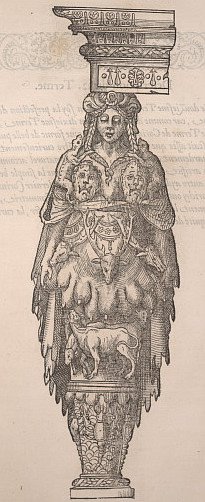
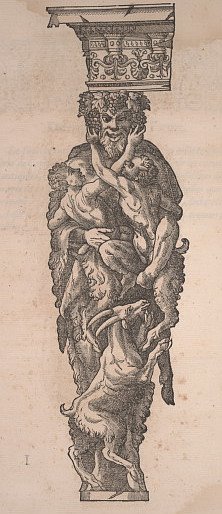





These extraordinary baroque column figures were produced in 1572 by the carpenter, sculptor and Dijon architect, Hugues Sambin.
As best I can make out, Sambin set down in anthropomorphic form the 'terms' of architecture to that point in time including ionic, doric, corinthian, tuscan, composite and a sixth one Sambin came up with himself, that of a combination of the other forms. I think that this was an early use of these (now) common terms.
The figures themeselves were meant to display the contradictory principles of inventiveness and abundance (again, I think this is Sambin's notion of the 6th term) of the renaissance period within the constraining nature of architecture.
The hugely embellished forms depicted did not have any great sway over the world of architecture except in so far as they reflected the decorative style seen particularly in some Italian constructions.
However, this work helps to explain where Joseph Boillot obtained the inspiration for his book from 20 years later that had less of the human and more of the animal as ornamental elements in columns -- see this previous post: Architectural Zoology. Sambin is apparently mentioned by Boillot in his book.
The above images come from an obscure goldmine. I stumbled into an academic's index list with a large number of fully digitized books (emblem/poetry/missals/iconography etc etc). I won't post the link yet until I've ransacked lovingly examined all the material - just in case traffic causes them to take the site offline.
But all the images from Oeuvre de la diversité des termes dont on use en architecture, réduict en ordre par maistre Hugues Sambin are available at Centre d'Études Supérieures de la Renaissance. Click 'mode image' at the bottom of the page. Although the images are larger I think the above jpegs are better quality. There are another 15 or 20 illustrations in addition to those here - which I've posted at full size.
Here's the translation of the review of Oeuvre - it's from an architectual point of view so tends towards the esoteric, irrespective of translational anomalies.
Sunday, February 05, 2006
Sweet Beasts
Mnemosyne: "The educational website for Museum Meermanno is up and running. Based upon the material that was prepared for the combined website of the Koninklijke Bibliotheek and Museum Meerman, we prepared essays that introduce the material to users in an educational setting. Teachers and students will be encouraged to add material and/or their comments. We used the concept of "topicmaps" to structure a large part of the website. We also tried to facilitate the retrieval of information via Iconclass notations for non-expert users.
And the Meermanno website, from whence the above manuscript images were obtained, is a wonderful (?)new repository. I have hardly looked around in there at all but it seems to be a novel multi-categorizing database: these miniatures took me 5 minutes to find and extract despite there being only occasional english. If NYPL is the toystore, Meermanno feels like the candy factory - I absconded quickly, without background information on the illustrations to avoid cavities.

Saturday, February 04, 2006
The Print Farm
The 37 Nats of Burma
predating the advent of Theravāda Buddhism but coexisting with it and
with other systems of divination and prediction such as astronomy and alchemy."
"The Burmese ideas of Sentient Beings, borrowed from India, represent a philosophy dealing with the evolution of the soul. First, in the Nether Worlds we have the evil soul, then in the present world we have the normal soul of man, rising to the higher soul of the angel in the nearer heavens. Next we have the soul getting the better of the body in the Rúpá world of the higher angels, and lastly, the soul dissociated from the body in the Arúpá, or immaterial, worlds, waiting for Nirvána or diccolution". In the Burmese Buddihist Cosmogony, all living beings are divided into three classes: - Kamá, generating; Rúpá, corporeal ungenerated; Arúpá, incorporeal. These three classes are a divided into thirty-one species, each with its bón (bhúmi, place, state, stage, region) or seat. [...] "
"In the centre are those who are undergoing various punishments. Below these is depicted an unfortunate about to enter and begging for mercy, and near him is to be seen another who is reluctant to go forward and is being dragged and goaded onward. At the bottom of the picture is Thagyá judging the deceased; behind him are the four executioners. At the four corners are the abodes of the four great executioners -Yamahlá, Yamada, Yamaká and Yamamin, the abode of the last being represented as empty"

The thirty-seven nats, a phase of spirit-worship prevailing in Burma, by Sir R. C. Temple. With full-page and other illustrations. (published 1906) at NYPL
(where I spent way, way too much time today - like a child in a toyshop).
La Belle Epoque
Les Maitres de l'Affiche ('The Poster Masters') was a monthly subscription publication released by L'Imprimerie Chaix between 1895 and 1900 that featured high quality lithographic posters by more than 90 renowned international artists.
The series helped promote the art-nouveau posters as a serious form of art, worthy of collection, media review and exhibition. The vivid colours and widespread appeal assured that this medium would come to typify fin de siècle Parisian society.
5 volumes (259 posters) were issued as Les maîtres de l'affiche : publication mensuelle contenant la reproduction des plus belles affiches illustrées des grands artistes, français et étrangers, éditée par L'Imprimerie Chaix and are online at NYPL (22 thumbnail pages).
Jules Chéret was the artistic director of the printery and contributed more than 60 posters to the series himself in addition to the magazine covers and works advertizing books, novels, plays &c.
